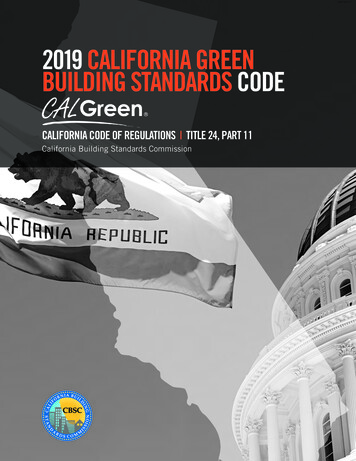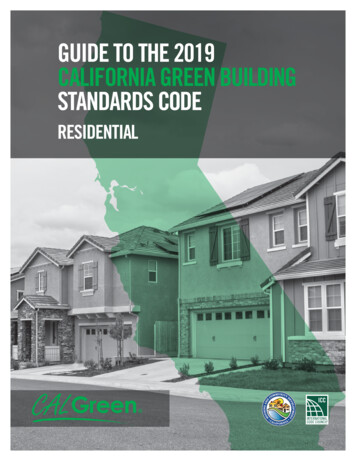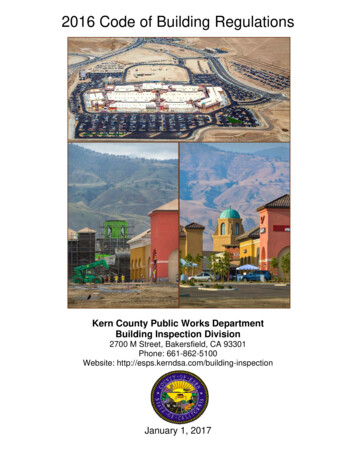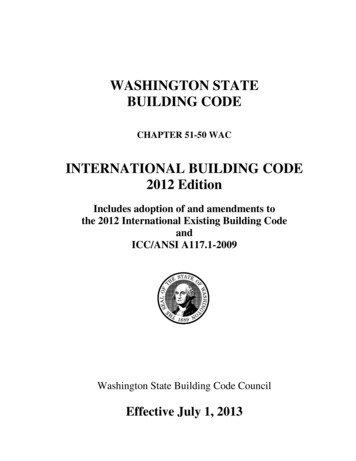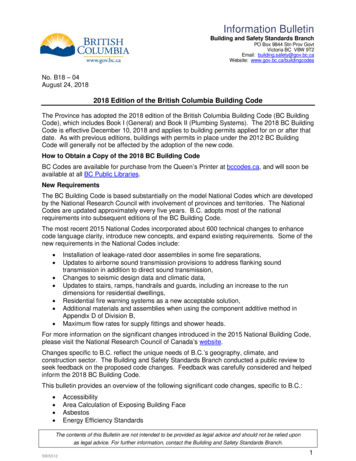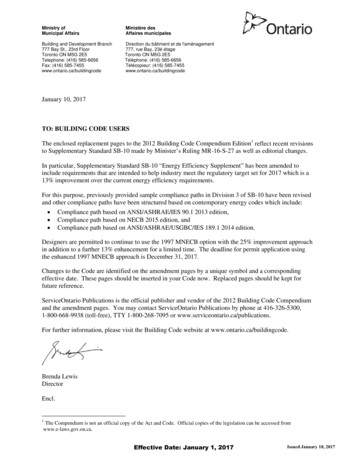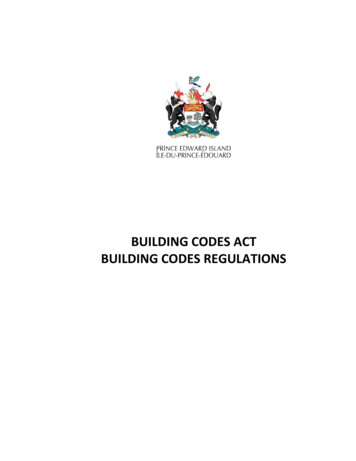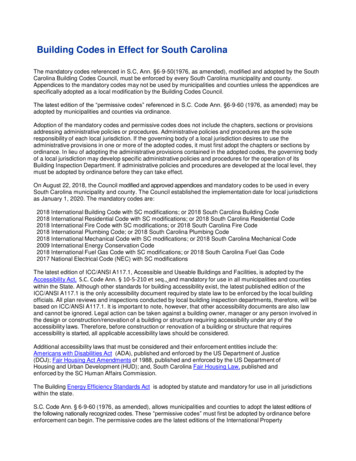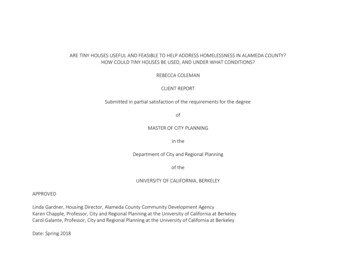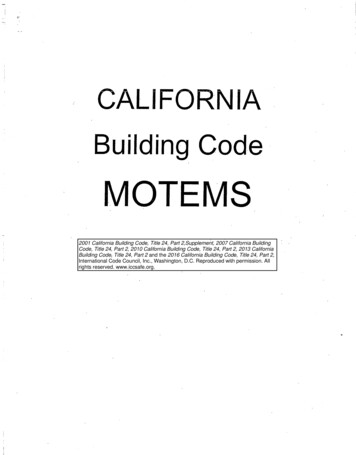
Transcription
CALIFORNIABuilding CodeMOTEMS2001 California Building Code, Title 24, Part 2,Supplement, 2007 California BuildingCode, Title 24, Part 2, 2010 California Building Code, Title 24, Part 2, 2013 CaliforniaBuilding Code, Title 24, Part 2 and the 2016 California Building Code, Title 24, Part 2,International Code Council, Inc., Washington, D.C. Reproduced with permission. Allrights reserved. www.iccsafe.org.
REVISION RECORD FOR THESTATE OF CALIFORNIASUPPLEMENTJanuary 31, 20052001 Title 24, Part 2, California Building CodePLEASE NOTE: The date of this Supplement is for identification purposes only.See the History Note Appendix for the adoption and effective dates of the provisions.It is suggested that the section number as well as the page number be checked when inserting this material and removing the supersededmaterial. In case of doubt, rely on the section numbers rather than the page numbers because the section numbers must run consecutively.It is further suggested that the superseded material be retained with this revision record sheet so that the prior wording of any section canbe easily ascertained.Please keep the removed pages with this revision page, for future reference.NOTE.Due to the fact that the application date for a building permit establishes the California Building Standards code provisions that areeffective at the local level, which apply to the plans, specifications, andconstruction for that permit, it is strongly recommended that theremoved pages be retained for historical reference.VOLUME 1Remove Existing Pages1-xvi.3 and 1-xvi.41-xvi.27 and 1-xvi.281-449 and 1-450Item No. 5510A028Insert Blue Pages1-xvi.3 and 1-xvi.41-xvi.27 and 1-xvi.281-294.25 through 1-294.841-449 and 1-450
r '' ' ' 1
MATRIX ADOPTION TABLES-VOLUME 1CHAPTER 1—ADMINISTRATIONENFORCING AUTHORITYLOCAL BUILDING STATE AGENCYHCDCECADOPTING AGENCY11ACCAOSHPD12DSAACOWNAGRBOCBSCOSASS1234Adopt entire UBCchapter withoutamendmentsDOSH SL4Adopt entire UBC .chapter as amended(amended sections listedbelow)X'XXXX.Adopt only thosesections that arelisted belowXXX X XXXXXXXXXXXXXXXXXXXXXXXXXXXXXXXXXXX XXXXXXXXXX101.4 - 101.4.1CAXXXXXXXXXX.X XXXXXXXCAXXX101.5X. XXXXX. XXXXXXXXXXX . X101.9.2CAXXX101.11CAXXXX101.12CAXX XX101.13CAXXX 101.14CAXXX101.15CA X101.16CAXXXXXXXXXX. 11CA101.17.12CA101.17.14CA102.1 .CA102.2CA102.2.1CA102 XX'X'X 44XXXXCA104.2.1.1CAXCAXCAXX CA,'X103.2.2104.2.1.1.1 X104104.2.1.1.2SLCXX(Continued)JANUARY 31, 2005 SUPPLEMENT1-XvI.3
CHAPTER 1—ADMINISTRATION—(Continued)ENFORCING AUTHORITYLOCAL BUILDING OFFICIAL ADOPTING LTHOFFICIALSFMOHSSTATE 1.3CAX104.2.3.1CAXX104.2.8.1CAX104.2.8.1.1CAX i104.2.8.1.2CAX104.2.8.2CAX165.1.1CA X106.2CAX106.3.3.1 - 106.3.3.4 CAX .106.4.1CAX106.4.2.1CAX 107.1.1CAX107.1.2CAX107.6.1CA X108 - 108.5.1UBCX108.1.1CAX108.5.1CAX108.5.2CAX l08.5.3CAX108.5.4 - 108.8UBCX.108.5.4CA X108.5.5CAX108.5.6CAX108.6 UBCX . 109UBC X*DOSH has not adopted the 1997 edition of the Uniform B gilding Code. The 1995 edi ion of the California Building Code remains effective.The designation indicates that the State Fire Marsha 's adoption of this chapter or individual sections is applicable tostructures subject to HCD 1 and/or HCD 2.1 -xvi.4JANUARY 31, 2005 SUPPLEMENT
CHAPTER 31C—RADIATION'ENFORCING AUTHORITY.LOCAL BUILDING STATE AGENCYHCDADOPTING AGENCYCACEC1/AC12DSAACAdopt entireCalifornia chapterDWRAGRBOCOSHPDDSASSBSC1234DOSH'SLX*DOSH has not adopted the 1997 edition of the Uniform Building Code. The 1995 edition of the California Build!, g Code remains effective.The designation indicates that the State Fire Marshal's adoption of this chapter or individual sections is applicable tostructures subject to HCD 1 and/or HCD 2.CHAPTER 31D—FOOD ESTABLISHMENTSENFORCING AUTHORITYLOCAL BUILDING STATE AGENCYHCDADOPTING AGENCYCECCA1/ACAdopt entireCalifornia chapter1DSAAC2OSHPD DWRAGRBCCDSASSBSC1234DOSH'SLX*DOSH has not adopted the 1997 edition of tile Uniform Building Code. The 1995 edition of the California Build!, g Code remains effective.The designation indicates that the State Fire Marshal's adoption of this chapter or individual sections is applicable tostructures subject to HCD 1 and/or HCD 2.CHAPTER 31E—TENTS AND MEMBRANE STRUCTURESENFORCING AUTHORITYLOCAL BUILDING STATE AGENCYHCDADOPTING AGENCYCECCA1/AC1 DSAAC2OSHPDAdopt entireCalifornia chapterDWRAGRBOOUSAssBSC1234DOSH*SLX*DOSH has not adopted the 1997 edition of the Uniform Building Code. The 1995 edition of the California Buildir g Code remlins effective.The 1 designation indicates that the State Fire Marshal's adoption of this chapter or individual sections is applicable tostructures subject to HCD I and/or HCD 2.CHAPTER 31F—MARINE OIL TERMINALSENFORCING AUTHORITYLOCAL BUILDING NSSTATE AGENCYHCDADOPTING AGENCYCEC CA1/AC1DSAAC2OSHPDDWRAGRBOCBSC1SSA234DOSH'ELAdopt entireCalifornia chapterSLCX*DOSH has not adopted the 1997 edition of he Uniform Building Code. The 1995 edition of the California Bt ilding Code remains effective.CHAPTER 32—CONSTRUCTION IN THE PUBLIC RIGHT OF WAYENFORCING AUTHORITYLOCALFIREOFFICIALLOCAL BUILDING OFFICIALLOCALHEALTHOFFICIALSTATE AGENCYHCDADOPTING AGENCYCECAdopt entire UBCchapter CX DSASsOSHPD12XX34DOSH.SLXAdopt entire UBCchapter as amended(amended sectionslisted below)Adopt only thosesections that arelisted below*DOSII has not adopted II e 1997 edition of the Uniform Building Code. The 1995 edition of the California Buildir g Code remlins effective.The 4 designation indicates that the State Fire Marshal's adoption of this chapter or individual sections is applicable tostructures subject to I ICD I and/or I I CD 2.JANUARY 31, 2005 SUPPLEMENT1-xvi.27
CHAPTER 33—SITE WORK, DEMOLITION AND CONSTRUCTIONENFORCING AUTHORITYLOCAL BUILDING OFFICIALCEC1/ACCAAdopt entire UBCchapter withoutamendments1XLOCALHEALTHOFFICIALSFMDNSSTATE AGENCYOSHPDHCDADOPTING dopt entire UBCchapter as amended(amended sectionslisted below)X.23XXX4DOSH'SLXiAd,opt only thosesections that are listedbelow. 3301.1CAXX3301.2aCAXXX3301.3CA.XXX*DOSH has not adopted the 1997 edition of the Uniform Building Code. The 1995 edition of the California Buildit g Code remains effective.The designation indicates that the State Fire Marshal's adoption of this chapter or individual sections is applicable tostructures subject to HCD 1 and/or HCD 2.CHAPTER 34—EXISTING STRUCTURESENFORCING AUTHORITYCEC1/ACCA12STATE AGENCYDSA'SFMAdopt entire UBCchapter withoutamendmentsOHSDWRX.AGR BOCDSASSBSCX12X34DOSH SLX .Adopt entire UBCchapter as amended(amended sectionslisted below)'Adopt only thosesections that are .listed below3401 NoteCA3401.1CA3401.2CA3405UBC3405.1UBCDivision IILOCALHEALTHOFFICIALOSHPDHCDADOPTING AGENCYLOCALFIREOFFICIALLOCAL BUILDING OFFICIALCAXXXXXX.XX . X X.XX*DOSH has not adopted the 1997 edition of the Uniform Building Code. The 1995 edition of the California Building Code remains effective.The designation indicates that the State Fire Maishal's adoption of this chapter or individual sections is applicable tostructures subject to HCD I and/or HCD 2.1-xvi.28JANUARY 31, 2005 SUPPLEMENT
CHAP. 31F, DIV. I3101F3101F.6.22001 CALIFORNIA BUILDING CODEChapter 31F [For SLC]MARINE OIL TERMINALSDivision ILLLLLLLLL11LLL. .: LLLLLLLLLLLLLLLLLLcA SECTION 3101 F ISLC] — INTRODUCTION3101F.1 General. The Lempert-Keene-Seastrand oil spill prevention and response act of 1990 (act), as amended, authorized theC California State Lands Commission (SLC) to regulate marine oilC terminals (MOTs) in order to protect public health, safety, and theC environment. The authority for this regulation is contained in Sections 8755 and 8756 of the California Public Resources Code.CThis act defines "oil" as any kind of petroleum, liquid hydrocarCbons, or petroleum products or any fraction or residues thereof,Cincluding but not limited to, crude oil, bunker fitel, gasoline, dieselCC fuel, aviation fuel, oil sludge, oil refuse, oil mixed with waste, andAliquid distillates from unprocessed natural gas. The provisions ofC this Chapter regulate marine oil terminals as defined under thisC act. . 101F.2 Purpose. The purpose of this Code is to establish minimum engineering, inspection and maintenance criteria for MOTSin order' to prevent oil spills and to proted public health, safetyand the environment. This Code does not,. in general, address operational requirements. Relevant provisions from existing codes,industry 'standards, recommended practices, regulations andguidelines have been incorporated directly or through reference,as part of this Code.' Where there are differing requirements between this Code andlor references cited herein, the choice of application shall be subject to approval of the Marine Facilities Division (Division) of theSLC. In special circumstances where certain requirements of theSestandards cannot be nzet, alternatives that provide an equal or better protection of the public health, safety and the environmentshall be subject to Division approval.C C3101F.3 Applicability. The provisions of this Chapter are applieA cable to the evaluation of existing MOTs and design of new MOTsLA in California. Each provision is classified as New (N), ExistingL eL AL e (E), or Both (NIE) and shall be applied accordingly. If no.classifiL cA cation is indicated, the classification shall be considered to beLL A (NIE).LL AExisting (E) requirements apply to MOTs that are in operationL L eL A on the date this Code is adopted. For these MOTs, equivalent orL Ain-kind replacement of existing equipthent, short pipeline secL eL A dons, or minor modification Of existing components shall also beLL A subject to the existing (E) requirements.LL A New (N) requirements apply to:cAI. A MOT or berthing syStem (subsection 3102E1.3) that comLL e nzences or recommences operation with a new or modified operaL e lions manual after adoption of this Code.LL2. Addition of new structural components or systems at an exLA isting MOT that are structurally independent of existing compoL eLrents or systems.L eAL A*3. Addition of new (non-replacement) equipment, piping, pipeL cA c Imes, components or systems to an existing MOTt. AI. C4. Major repairs or substantially modified in-place systems.1. A1.5.Any associated major installations or modifications.ALL1.LLC 3101F.4 Overview. This Code ensures that a MOT can be safelyA operated within its inherent structural and equipment-relatedA constraints.JANUARY 31, 2005 SUPPLEMENTSection 3102F defines minimum requirements for audit, inspection and evaluation of the structural, electrical and mechanicalsystems on a prescribed periodic basis, or following a significantdamage-causing event.Section 3103E 3104F and 3 107F provide criteria for structuralloading, deformation and performance-based evaluation considering earthquake, wind, wave, current, seiche and tsunami effects.Section 3105F provides requirements for the safe mooring andberthing of tank vessels and barges. Section 3106F describes requirements for geotechnical hazards and foundation analyses, including consideration of slopestability and soil failure.Section 3108F provides requirements for fire prevention, detection and suppression including appropriate water and foam volumes.Sections 3109F through 31011F provide requirements for piping, mechanical and electrical equipment.English units are prescribed herein; however, many of the unitsin the references are in System International (SI).3101F.5 Risk Reduction.Risk reduction strategies,such as pipeline segmentation devices, system flexibility and spillcontainment devices may be used to reduce the size of a potentialoil spill. Such strategies may reduce theMOT risk classification asdetermined from Table 31F-4-1.3101F.6 Review Requirements.310.1F.6.1 Quality Assurance. All audits, inspections, engineering analyses or design shall be reviewed by a professional havingsimilar or higher qualifications as the person who performed thework, to ensure quality assurance. This review may be pet fornzedin-house.Peer review is required for nonlinear dynamic structural analyses and alternative lateral force procedures not prescribed herein.The peer review may be from an independent internal or externalsource. The peer reviewer shall be a California registered civil orstructural engineer: 3101F.6.2 Division Review. The following will be subject to review and approval by the Division or its designated representative(s) for compliance with this Code:I. Any audit, inspection, analysis or evaluation of existingMOTs.2. Any significant change, modification or re-design of a structural, mooring, fire, pipinglpipelines, mechanical or electricalsystem at an existing MOT, prior to use or reuse.3. Engineering analysis and design for any new MOT prior toconstruction.4. Construction inspection team and the construction inspection report(s).Authority: Sections 8755 and 8757, Public Resources Code.Reference: Sections 8750, 8751, 8755 and 8757, Public ResourcesCode.1-294.25
CHAP. 31F, DIV. 23102FTABLE 31F-2-22001 CALIFORNIA BUILDING CODEDivision 2LLLLt.r.LLLeAACAC'ACAcSECTION 3102F — AUDIT AND INSPECTION"berthing systems." A berthing system consists of the wharf andsupporting structure, mechanical and electrical components thatserve the berth and the entire pipeline from the loading arm ormanifold to the last valve before the pipeline enters a tank storagearea.3102F.1 General.3102F.1.1 Purpose. Section 3102F defines rnirtirnuun requiremews for audit, inspection, and evaluation of the structural, mechanical and electrical components and systems. For example, a MOT consisting of wharves with three berthsadjacent to the shoreline could contain three independent "berthing systems" if the piping does not route through adjacent berths.Therefore, a significant defect that would restrict the operation ofone berth would have no impact on the other two berths. Conversely, if a T-head Piet; with multiple berths sharing a trestle thatsupports all piping to the shoreline, had a significant deficiency onthe common trestle, the operation of all berths could be adverselyimpacted. This configuration is classified as a single berthing system.A3102F.1.2 Audit and Inspections Types. The audit and inspeccA Lions described in this Chapter (31F) and 2 CCR 2320 (a) and (b)[2.11 are:A 1. 'Annual InspectionA2. AuditCA3. Post-Event InspectionAEach has a distinct purpose and is conducted either at a definedA interval (see Tables 31F-2-1 and 31F-2-2), as a result of a potenAA daily damaging event Or a significant change in operations. In theA time between audits and inspections, operators are expected toA conduct periodic walk-down examinations of the MOT to detectpotentially unsafe conditions. C.A. CALLLLLLLLCCTABLE 31F-2-1INITIAL AUDIT REPORT SUBMISSION DEADLINEFOR EXISTING BERTHING SYSTEMSAIKCASFCTO [ACCCCCAACACACACACAThe physical boundaries of a berthing system may exclude unused sections of a structure. Excluded sections nutst be physicallyisolated from the berthing system. Expansion joints may providethis isolation.3102F.1.4 Records. All MOTs shall have records reflecting current, as-built conditions for all berthing systems. Records shall include, but not be limited to modifications and/or replacement ofstructural Components, electrical or mechanical equipment orrelevant operational changes, new construction including designdrawings, calculations, engineering analyses,- soil borings,equipment manuals, specifications, shop drawings, technical andmaintenance manuals and documents.SBISO EDIEih3 ots Mdu 4 otsLw6 otsAs defined in Tables 31F-4-1 and.34f":56:"'From the effective date of this Chapter (37E).Chronological records and reports of Annual Inspections, Audits and Post-Event Inspections and documentation of equipmentor structural changes shall be maintained.3102E1.3 Berthing Systems. For the purpose of assigning structural ratings and documenting the condition of mechanical andelectrical systems, an MOT shall be divided into independentRecords shall be indexed and be readily accessible to the Division (see 2 CCR Section2320 (c) (2)) [2.1].CCTABLE 31F-2-2MAXIMUM INTERVAL BETWEEN UNDERWATER AUDIT INSPECTIONS (YEARS) 1CCCCCCCCCCCCCCCCCCAACAcAA CONDITION RATINGFROM oor)2(Serious)1(Critical)CONSTRUCTION MATERIALUnwrapped Timber or Unprotected SteelConcrete, Wrapped Timber, Protected Steel or(no coating or cathodic protection)4. Composite Materials (FRP, plastic, etc.)4Aggressive3Aggressive3Benign2 EnvironmentEnvironmentBenIgn2 EnvironmentEnvironment6465. 6465CHANNEL BOTTOM OR MUD LINE—SCOUR4AggresehmaEnvironment5Benign2 Environment6-6553 5.-46543546572222N/A5N/A5NIA5N/A5N/A52N/A5 7 le maxznuun intetvalbetween UnderwaterAuditThspectionsshall be reduced as appropriate based on the extent ofdeterioration obserVedona structure, the rateof further anticipated deterioration or other factors.213E11;5II C111,1:Init water unit nuairman current velocities less than 1.5 knots for the majority of the days in a calendar year.3Aggressive environments include brackish or salt water, polluted watewater;or waters with current velocities greater than 1.5 knots for the majority of the days in thecalendar year:most structures, two maximum intervals will be shown in this table, one for the assessment of construction material (timber; concrete, steel, etc.) and one forscour (last 2 columns). The shorter interval of the two should dictate the maximum interval used.'MOTs rated "Critical" will not be operational; and Emergency Action shall be required in accordance with Thble 31F-2-7.1-294.26JANUARY 31, 2005 SUPPLEMENT
CHAP. 31F, DtV. 231o2F.1.53102F.3.4.32001 CALIFORNIA BUILDING CODEL c 3102F.1.5 Baseline Inspection. If "as-built" orsubsequent 17I odification drawings are not available, incomplete, or inaccurate,the Audit must include a Baseline Inspection to gather data ill suf.ficient detail to adequately evaluate the MOTLL AL CL ('.\.LACACACACThe level of detail required shall be such that structural membersizes, connection and reinforcing details are docunzenied, if re(mired in the structural analysis. In addition, the strength and/or'ductility cnaracteristics of construction materials shall be deter'z. C rained, as appropriate. Nondestructive testing, partially destrucL AL C tive testing and/or' laboratory testing methods may be used.LLLLL!.L AL 'CLL CC. AL CAll fire, piping, mechanical and electrical systems shall be documented as to location, capacity, operating limits and physicalconditions.LC LLL A 3102F.2,,Annuallnspection. The Annual Inspection required byL C 2 CCR 2320 (a)(1)12.1] , may include an engineering examination L Aof the topside and underside areas of the dock,' including theLAsplash zone. TheDivision shall perform the inspection, with coopLAL C eration from the owner/operator. Observations Will be recordedL Aand a report violations and deficiencies shall be provided to theLLC operator. L ALSubject to operating procedures, a boat shall be provided to faL ALL A cilitate the inspection of the dock undersides and piles down to theLsplash zone. If a boat is not available or the under dock inspectionL ALcannot be performed by the Division during the Annual InspecL ALtion, the MOT operator shall carry out or cause to be carried out,,L Asuch an inspection. The operator will then provide the DivisionL Awith a report detailing the examination resultsLLL c4 atelyideLe ,piCt./46. 4.1N.Pf theadidersideof thedocka,L ALALLAc LLL3102F.3LLLL ACACA3102F.3.2 Overview. The Initial Audit shall include above waterc and underwater structural inspections, mooring, berthing andL AL C structural evaluations; and electricallmechanical systems evaL 8 illation. The audit is performed by a multidisciplinary team of eneA gineers, qualified inspectors and may include Divisionrepresentatives.L CL ALLLLLLACACACAL. CLThe above water inspection involves an examination of allstructural, mechanical and electrical components above the waterline. Structural defects and their severity 'shall be documented,but the exact size and location of each deficiency is typically notrequired.L CACL AL CL ARepresentative underwater sampling may be acceptable withDivision approval, for cases of limited visibility, heavy marinegrowth, restricted inspection times because of environmental fact: A tors (currents, water temperatures, etc.) or a very large number ofLAA piles [2.2].L CA global Condition Assessment Rating (CAR) shall be assignedL eL A to above and underwater structural systems (Table 31F-2-5).L CL ALRemedial Action Priorities (RAP) shall be assigned for compoL c went deficiencies (Table 31F-2-6). Recomnzendations for remediAL C ation and/or upgrading shall be prescribed as necessary.L ALLL c:L A3102F.3.3.1 Initial Audit. Table 31F-2-1 provides the deadlinesfor the submission of the Initial Audit report. The MOT classification in Table 31F-2-1 is deterrnined from the higher assigned riskclassification obtained from Table 31F-4-1.For a new MOT berthing system, the Initial Audit shall be performed within three years of commencement of operations.3102F.3.3.2 Subsequent Audits. An above water A udit of structural, mechanical and electrical systems shall be completed at amaxinzum interval of 3 years. This interval nitiy be reduced, basedon the recommendation of the A udit Team Leader; and with the approval of the Division, depending on the extent and rate of deterioration or other factors.The maximum interval for underwa ter Audits is dependent uponthe condition of the facility, the construction material type and/orthe environment at the mane, as shown in Table 31F-2-2.If there are no changes in the defined purpose (see subsection3102F.3.6.1) of the berthing system, then analyses from previousAudits may be referenced However, if there is a significant changein a berthing system, or when deterioration or damage must beconsidered, a new analysis may be required.The Division may require an Audit to justify changes in the useof a berthing system. An example of such change would be in theberthing and mooring configuration of larger or smaller vesselsrelative to dolphin and fender spacing, and potential resultantmodification to operational environmental limitations (e.g. wind speed).Subsequent audits of the above water and underwater struc,tures and mechanical and electrical systems may or May not beperformed concurrently, depending upon-the required inspectionintervals based on the prior audit report.AAA 3102F.3.1 Objective.The objective of the Audit is toreview structural,mechanicaland electrical systems on a prescribed periodicLLi" A. basis to verify that each berthing system is fit for its specific deL c fined purpose. The Audit includes both above water and underwaL AL C ter inspections, as well as engineering analyses.ALL3102F.3'.3 Schedule.An Audit is not considered complete until the Audit Report is received by the Division.JANUARY 31, 2005 SUPPLEMENT3102F.3.4 Audit.Team.3102F.3.4.1 Project Manager. The Audit shall be conducted by amultidisciplinary team under the direction of a Project Managerrepresenting the MOT The Project Manager shall have specificknowledge of the MOT and may serve other roles on the Audit Team.CCCCCCC3102F.3.4.2 Audit Team Leader. The Audit Team Leader shalllead the on-site audit team and shall be responsible for directing Cfield activities, including the inspection of all structural, mechani- Ccal and electrical systems. The Team Leader shall be a California Cregistered civil or structural engineer and may serve other roles CCon the audit team.A3102F.3 .4.3 Structural Inspection Team. The structural inspec- CAlion shall beconducted under the direction of a registered civil or c Astructural engineer.AAll members of the structural inspection team shall be gradu- Aates of a 4-year civillstructural engineering, or closely related C(ocemilcoastal) engineering curriculum, and shall have been cer- Ctified as an Engineer-in-Training; or shall be technicians whohave completed a course of study in structural inspections. The Cnzininuan acceptable course in structural inspections shall in- Cclude 80 hours of instruction specifically related to structural in- Cspection, followed by successful completion of a comprehensive Cexamination. An example of an acceptable course is the U.S. De- Apartment of Transportation's "Safety Inspection of In-Service CBridges". Certification as a Level IV Bridge Inspector by the Na- CCtional Institute of Certification in Engineering Technologies (NI- ACET) shall also be acceptable [2.3].CFor underwater inspections, the registered civil or structural Aengineer directing the underwater structural inspection shall also A1-294.27
CHAP. 31E DIV 23102E3.4.33102E3.5.3.2c be a conunercially trained diver or equivalent and shall activelycA participate in the inspection, by personally conducting a mini s mum of 25 percent of the underwater examination [2.4ACEach thiderwater team member shall also be a commerciallyAC trained diver, or equivalent. Divers performing manual tasks suchas cleaning or supporting the diving operation, but not conductingAC or reporting on inspections, may have lesser technical qualificalions 12.31.A3102F.3.4.4 Seismic Structural Analyst. A California registeredA civil or structural engineer shall perform the seismic structuralevaluation required for the Audit. AC3102F.3.4.5Electrical Inspection Team. A registered electrical4e engineer shall direct the on-site team performing the inspectione and evaluation of electrical components and systems.A3102F.3.4.6 Mechanical Inspection Team. A registered engicA neer shall direct the on-site 'team performing the inspection ofC pipeline, mechanical and fire systems.C 3102F.3.4.7 DivisionalRepresenttgign The Division representative(s) may participate in any Audit as observer(s) and may proA vide guidance.ACA3IO2F.3.5 Scope of Inspection. 3102F.3.5.1 Above Water Structural Inspection. The above waA ter inspection shall include all accessible components above 3 ftMLLW. Accessible components shall be defined as those compoAAabove and below deck that are reachable without the needA for excavation or extensive' removal of materials that may impaircA visual inspection. The above water inspection shall include but„ not be limited to the following:A I. PilesA 2. Pile capsA 3. BeamsACA 4. Deck soffitA 5. BracingA6. Retaining walls and bulkheadsAA7. ConnectionsCA8. SeawallsC9. Slope protectionCC10. Deck topsides and curbingC11. Expansion jointsC12. Fender system componentsCC13. Dolphins and deadmenC14. Mooring points and hardwareC15. Navigation aidsCA16. Platforms, ladders, stairs, handrails and gangwaysC17. Backfill (sinkholesldifferential settlement)C C3102F.3.5.2 Underwater Structurallnspection. The underwatere inspection shall include all accessible components from 3 ftA MLLW to the nuidline, including the slope and slope protection, inA areas, immediatelysurrounding the MOT The water depth at thecA, „,ucrsiza0,2 CPCi Iliaiking theUl tOct tied drujiA specified in the MOT's Operations Manual (2 CCR 2385 (d))cp; [2.11.Ce The underwater structural inspection shall include the Level I,A II and III inspection eftbrts, as shown in Tables 3 IF-2-3 and1-294.2802001 CALIFORNIA BUILDING CODE31F-2-4. The underwater inspection levels of effort are describedbelow, per [2.31:Level I—Includes a close visual examination, or a tactile examination using large sweeping motions of the hands where visibility is. limited. Alth ough the Level I effort is often referred to as a"Swim-Dy" inspection, it must be detailed enough to detect obvious major damage or deterioration due to overstress or other severe deterioration. It should confirm the continuity of the fulllength of all members and detect undermining or exposure of normally buried elements. A Level I effort may also include limitedprobing of the substructure and adjacent channel bottom.Level I.14 detailed inspection which requires marine growthremoval from a representative sampling of components within thestructure. For piles, a 12-inch high band should be cleaned at designated locations; generally near the low waterline, at the mudline, and midway between the low waterline and the nuidline. On arectangular pile, the nzarinesrowth removal should include atleast three sides; on an octagon pile, at least six sides; on a roundpile; at least three fourths of the perimeter On large diameterpiles, 3 ft or greater marine growth removal should be effected on1 ft by 1 ft areas at four loCations approximately equally spacedaround the perimeter at each elevation. On large solid faced elements such as retaining structures, marine growth removal shouldbe effected on 1 ft by 1 ft areas at the three specified elevations. Theinspection should also focus on typical areas of weakness, such asattachment points and welds. The Level II effort is intended to detect and identify damaged and deteriorated areas that may be hidden by surface biofouling. The thoroughness of marine growthremoval should be governed by what is necessary to discern thecondition of the underlying structural material. Removal of allbiofouling staining is generally not required.Level III—A detailed inspection typically involving nondestruc
*DOSH has not adopted the 1997 edition of the Uniform Building Code. The 1995 edition of the California Building Code remains effective. The designation indicates that the State Fire Maishal's adoption of this chapter or individual sections is applicable tostructures subject to H
